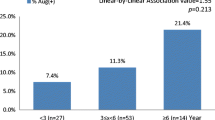Abstract
Restless legs syndrome (RLS) is a common sensorimotor disorder that frequently requires long-term treatment. Although dopamine agonists are commonly used to treat RLS, their long-term use is often complicated by worsening symptoms, loss of efficacy and augmentation (an iatrogenic worsening of RLS symptoms). It is important to consider various factors that can exacerbate RLS, and to implement treatment strategies to prevent and manage these complications.

Similar content being viewed by others
References
Mackie S, Winkelman JW. Long-term treatment of restless legs syndrome (RLS): an approach to management of worsening symptoms, loss of efficacy, and augmentation. CNS Drugs. 2015;29(5):351–7.
García-Borreguero D, Kohnen R, Silber MH, et al. The long-term treatment of restless legs syndrome/Willis-Ekbom disease: evidence-based guidelines and clinical consensus best practice guidance: a report from the International Restless Legs Syndrome Study Group. Sleep Med. 2013;14(7):675–84.
Tzonova D, Larrosa O, Calvo E, et al. Breakthrough symptoms during the daytime in patients with restless legs syndrome (Willis-Ekbom disease). Sleep Med. 2012;13(2):151–5.
Allen RP, Earley CJ. Augmentation of the restless legs syndrome with carbidopa/levodopa. Sleep. 1996;19(3):205–13.
Högl B, García-Borreguero D, Kohnen R, et al. Progressive development of augmentation during long-term treatment with levodopa in restless legs syndrome: results of a prospective multicenter study. J Neurol. 2010;257(2):230–7.
Winkelman JW, Johnston L. Augmentation and tolerance with long-term pramipexole treatment of restless legs syndrome (RLS). Sleep Med. 2004;5(1):9–14.
Silber MH, Girish M, Izurieta R. Pramipexole in the management of restless legs syndrome: an extended study. Sleep. 2003;26(7):819–21.
Lipford MC, Silber MH. Long-term use of pramipexole in the management of restless legs syndrome. Sleep Med. 2012;13(10):1280–5.
Allen RP, Chen C, García-Borreguero D, et al. Comparison of pregabalin with pramipexole for restless legs syndrome. N Engl J Med. 2014;370(7):621–31.
Oertel W, Trenkwalder C, Beneš H, et al. Long-term safety and efficacy of rotigotine transdermal patch for moderate-to-severe idiopathic restless legs syndrome: a 5-year open-label extension study. Lancet Neurol. 2011;10(8):710–20.
Trenkwalder C, Beneš H, Grote L, et al. Prolonged release oxycodone-naloxone for treatment of severe restless legs syndrome after failure of previous treatment: a double-blind, randomised, placebo-controlled trial with an open-label extension. Lancet Neurol. 2013;12(12):1141–50.
Silver N, Allen RP, Senerth J, et al. A 10-year, longitudinal assessment of dopamine agonists and methadone in the treatment of restless legs syndrome. Sleep Med. 2011;12(5):440–4.
Ondo WG. Methadone for refractory restless legs syndrome. Mov Disord. 2005;20(3):345–8.
Hornyak M, Grossmann C, Kohnen R, et al. Cognitive behavioural group therapy to improve patients’ strategies for coping with restless legs syndrome: a proof-of-concept trial. J Neurol Neurosurg Psychiatr. 2008;79(7):823–5.
Earley CJ, Connor J, García-Borreguero D, et al. Altered brain iron homeostasis and dopaminergic function in restless legs syndrome (Willis-Ekbom Disease). Sleep Med. 2014;15(11):1288–301.
Ghosh A, Basu D. Restless legs syndrome in opioid dependent patients. Indian J Psychol Med. 2014;36(1):85–7.
Author information
Authors and Affiliations
Consortia
Ethics declarations
The article was adapted from CNS Drugs 2015;29(5):351–7 [1] by salaried employees of Adis/Springer and was not supported by any external funding.
Rights and permissions
About this article
Cite this article
Adis Medical Writers. Adjust therapy for restless legs syndrome if symptoms worsen, efficacy is lost or iatrogenic augmentation develops. Drugs Ther Perspect 31, 433–436 (2015). https://doi.org/10.1007/s40267-015-0255-4
Published:
Issue Date:
DOI: https://doi.org/10.1007/s40267-015-0255-4




